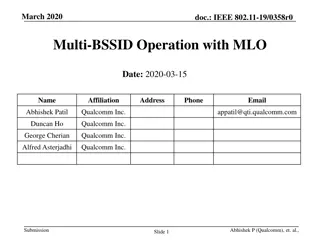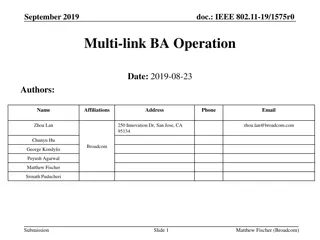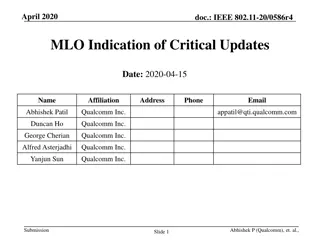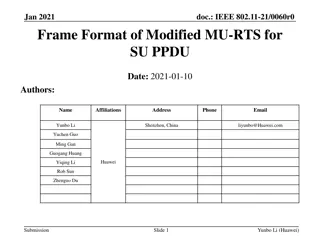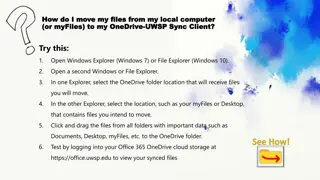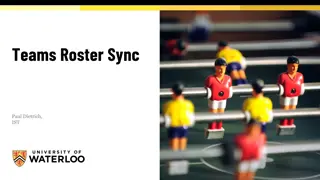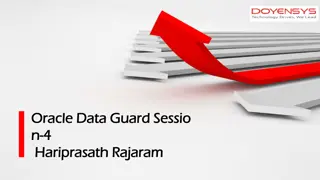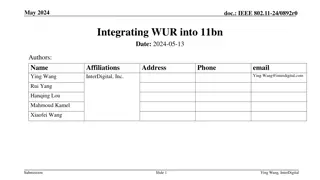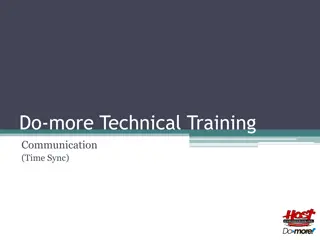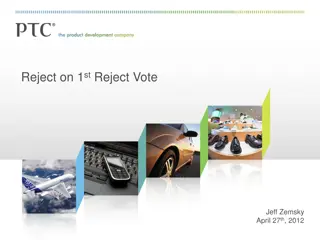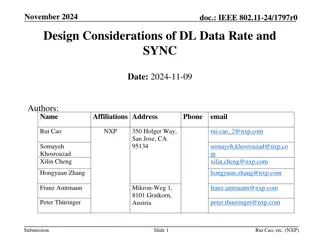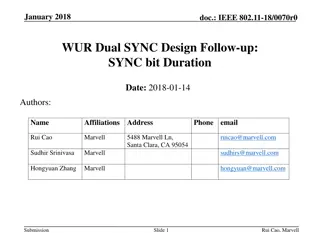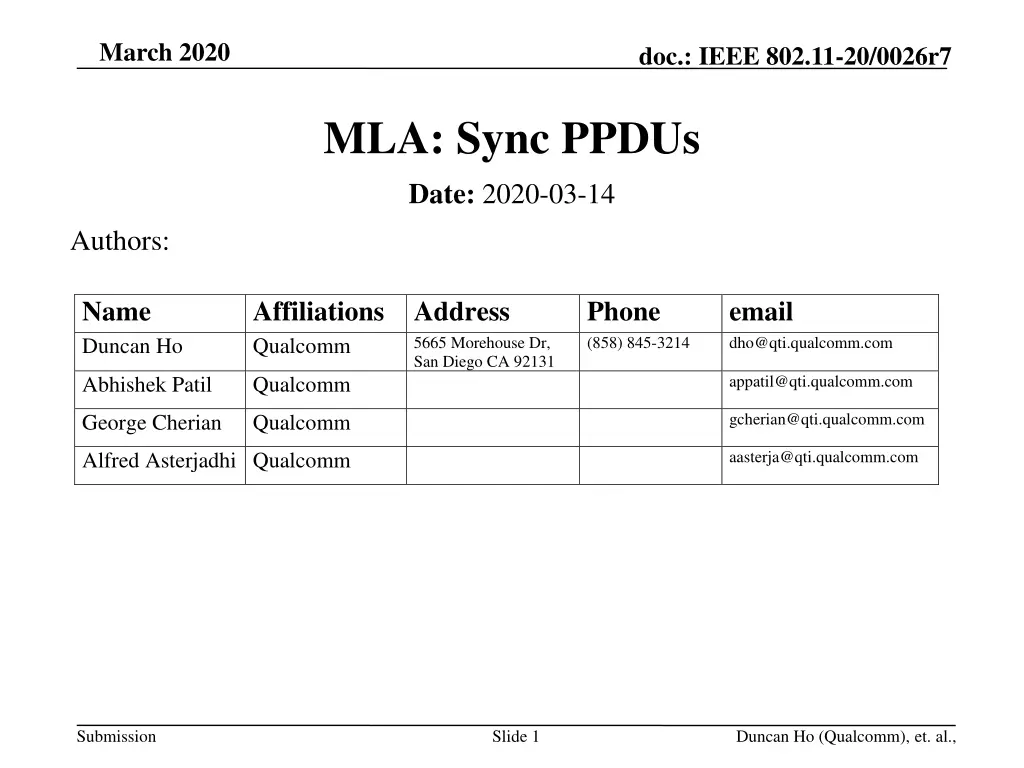
IEEE 802.11-20/0026r7 Update March 2020: Motions, Considerations & Terminology
Discover the latest updates from the IEEE 802.11-20/0026r7 document in March 2020. This presentation covers motions, considerations, and terminology related to simultaneous transmissions, throughput gains, latency improvements, and more in wireless communication standards.
Download Presentation

Please find below an Image/Link to download the presentation.
The content on the website is provided AS IS for your information and personal use only. It may not be sold, licensed, or shared on other websites without obtaining consent from the author. If you encounter any issues during the download, it is possible that the publisher has removed the file from their server.
You are allowed to download the files provided on this website for personal or commercial use, subject to the condition that they are used lawfully. All files are the property of their respective owners.
The content on the website is provided AS IS for your information and personal use only. It may not be sold, licensed, or shared on other websites without obtaining consent from the author.
E N D
Presentation Transcript
March 2020 doc.: IEEE 802.11-20/0026r7 MLA: Sync PPDUs Date: 2020-03-14 Authors: Name Duncan Ho Affiliations Address Qualcomm Phone (858) 845-3214 email dho@qti.qualcomm.com 5665 Morehouse Dr, San Diego CA 92131 appatil@qti.qualcomm.com Abhishek Patil Qualcomm gcherian@qti.qualcomm.com George Cherian Qualcomm aasterja@qti.qualcomm.com Alfred Asterjadhi Qualcomm Submission Slide 1 Duncan Ho (Qualcomm), et. al.,
March 2020 doc.: IEEE 802.11-20/0026r7 Background Motion #38 Move to add the followings to the 11be SFD: A MLD that supports multiple links can announce whether it can support transmission on one link concurrent with reception on the other link for each pair of links. Note - The 2 links are on different channels Note - Whether to define a capability of announcing the support transmission on one link concurrent with transmission on the other link is TBD. Motion #46 Move to add the following to the 11be SFD: Shall allow a multi-link device that has constraints to simultaneously transmit and receive on a pair of links to operate over this pair of links? Signaling of this constraints is TBD Submission Slide 2 Duncan Ho (Qualcomm), et. al.,
March 2020 doc.: IEEE 802.11-20/0026r7 Motivation As a follow-up to Motions #38 and #46, we provide some considerations in this presentation We focus on a very common scenario in this presentation: STR-AP with non-STR STA MLO offers: Throughput gain by concurrent transmissions on multiple links at the same time Latency improvements by contending on multiple channels Submission Slide 3 Duncan Ho (Qualcomm), et. al.,
March 2020 doc.: IEEE 802.11-20/0026r7 Terminology STR (simultaneous Tx and Rx) An MLD that is capable of simultaneous Tx/Rx on multiple links for the given set of links Non-STR An MLD that is not capable of simultaneous Tx/Rx on multiple links for the given set of links (i.e., it can only do Tx/Tx or Rx/Rx on all links) Submission Slide 4 Duncan Ho (Qualcomm), et. al.,
March 2020 doc.: IEEE 802.11-20/0026r7 Terminology: Sync PPDUs Two types of Sync PPDUs. Both have end-time aligned (within SIFS) PPDU1 PPDU1 4 3 2 1 0 Count down on a link 4 3 2 1 0 End times aligned Count down on both links End times aligned PPDU2 PPDU2 8 7 6 5 4 8 7 6 5 4 3 2 1 0 SYNC PPDU with SMEA SYNC PPDU without SMEA To achieve start time alignment, a modified EDCA can be used to access the 2nd link (see next slide) If start time alignment is not allowed: Start times may be different. End time is aligned + This mode is possible for DL (assuming AP is STR capable). AP counts down on each link independently + Not possible for UL, except for adding additional signaling Submission Slide 5 Duncan Ho (Qualcomm), et. al.,
March 2020 Sync Mode EDCA Access essentially EDCA with truncated countdown On the 2nd link The link performs normal EDCA countdown. If the countdown is on-going at the time the TXOP is acquired on the 1st link, the countdown counter is set to 0 instantly to allow the STA to tx on the link In that way, PD/NAV on 2ndlink will be honored i.e., don t access if NAV is set on 2nd link. Disruption to the 2nd link is largely addressed Can add further rules to limit the access to the 2nd link if needed e.g., 2nd link access only if RBO < a TBD Threshold value (configurable by AP) Compare to 80 + 80 access 80 + 80 does not check NAV on the 2nd link SMEA can further limit the access on the 2nd link by setting some threshold on the RBO doc.: IEEE 802.11-20/0026r7 Submission Slide 6 Duncan Ho (Qualcomm), et. al.,
March 2020 doc.: IEEE 802.11-20/0026r7 Pitfalls of No Sync PPDUs 11be protocol needs to be able to handle bi-directional traffic However, when bi-directional traffic is present, the UL traffic would wipeout a significant portion of the DL This would bring down the overall system throughput as the medium time for the lost DL is wasted UL transmission can lead to full DL loss if the DL s pre-amble is hit Submission Slide 7 Abhishek P (Qualcomm), et. al.,
March 2020 doc.: IEEE 802.11-20/0026r7 Pitfalls of No Sync PPDUs (Cont d) Neither option is good (Note BAs are not shown for simplicity) Option 1: STA Tx on Link 2 while Rx on Link 1 DL DL DL Link 1 Part of the PPDU is lost Due to UL interference Full PPDU is lost because preamble loss due to UL interference Link 2 UL = STA Tx/Rx interference, MPDU(s) lost Option 2: STA Holds on countdown on Link 2 while Rx on Link 1 STA holds off counting down on Link 1 due to Rx on Link 2 AP1 wins the TXOP again DL/OBSS DL DL/OBSS Link 1 AP2 wins the TXOP DL DL/OBSS Link 2 STA holds off counting down on Link 2 due to Rx on Link 1 Submission Slide 8 Abhishek P (Qualcomm), et. al.,
March 2020 doc.: IEEE 802.11-20/0026r7 The Proper Solution Sync PPDUs Guarantees fair medium access between AP and STA and no Tx/Rx collisions between links Both AP1 and STA1 contend for the medium Link 1 DL DL UL STA1 wins the medium DL DL Link 2 Submission Slide 9 Abhishek P (Qualcomm), et. al.,
March 2020 doc.: IEEE 802.11-20/0026r7 AP: MLD How Sync PPDUs can work with STR AP + Non-STR STA A1 A2 STA: Sa-MLD STA: Sb-MLD Multiple Primary channels allowed S1 S2 Sx Sy S1, A1 & Sx on Link1(L1) S2, A2, & Sy on Link2(L2) Sx, Sy means ANY STAs on L1, L2 STA/AP gets access to L1 UL DL L1+L2: Sync PPDUs See slide here. L1+L2 : Sync PPDUs See slide here. L2 is IDLE and SMEA is used on L2 L1: S1 sends PPDU1 to A1 L2: can be used for UL/DL for Sy. No constraints S2 cannot use until PPDU1-end-time o UL: blocked due to CCA. See slide here. L1: A1 sends PPDU1 to S1 L2: can be used for one of these: UL/DL for Sy. No constraints. See slide here. A2 sends DL for S2, with end-time same as PPDU1. S2 will not use L2 for UL. See slide here. L2 is IDLE and SMEA is not used L2 is BUSY@PPDU1 start, but later became IDLE during PPDU1 Submission Slide 10 Duncan Ho, Qualcomm Incorporated
March 2020 doc.: IEEE 802.11-20/0026r7 Conclusion To take full advantage of MLO, Sync PPDUs should be used for STR-AP + Non-STR STA configuration If a non-STR STA is associated with an AP that does not align the end times of the PPDUs, the following will suffer: Performance (i.e., throughput and latency. As shown in our simulation results (to be provided separately)) Power consumption of the STA To meet the Non-STR constraints, an STR-AP implements Sync PPDUs and this capability needs to be advertised Submission Slide 11 Duncan Ho (Qualcomm), et. al.,
March 2020 doc.: IEEE 802.11-20/0026r7 What s Needed in the Spec at a High Level Even though currently agreed Async mode does not prohibit a transmitter from aligning the end times of the PPDUs, there is no guarantee an AP will do that Therefore, we should let an AP advertise whether or not it will align the end times of the PPDUs So that a Non-STR STA can have a choice to associate only with those APs that can meet the Non-STR STA constraints Submission Slide 12 Duncan Ho (Qualcomm), et. al.,
March 2020 doc.: IEEE 802.11-20/0026r7 What s Needed in the Spec at a High Level (Cont d) AP MLD side: Signaling to indicate its capable of aligning the end times of the PPDUs Definition of the alignment of the end times of the PPDUs e.g., within SIFS If SMEA is used to access the 2nd link, define how to access the links other than the one that obtained the TXOP Honor PD/NAV on 2nd link. Don t access if NAV is set on 2nd link (Disruption to the 2nd link is largely addressed) Can add more rules to limit the access to the 2nd link e.g., 2nd link access only if RBO < a TBD Threshold value (configurable by AP) If SMEA is not used, each link accesses the channels independently Submission Slide 13 Duncan Ho (Qualcomm), et. al.,
March 2020 doc.: IEEE 802.11-20/0026r7 What s Needed in the Spec at a High Level (Cont d) STA MLD side: Signaling to indicate the non-STR constraints Already motioned (refer to Motion #46) If SMEA is used, procedures of how to access the links other than the one that obtained the TXOP Same as those in the AL MLD side (see the previous slide) Submission Slide 14 Duncan Ho (Qualcomm), et. al.,
March 2020 doc.: IEEE 802.11-20/0026r7 SP1 Do you agree to the following? In R1 of the spec, supporting the following cases: STR AP MLD with STR non-AP MLD STR AP MLD with non-STR non-AP MLD Note: All the other cases are TBD Submission Slide 15 Duncan Ho (Qualcomm), et. al.,
March 2020 doc.: IEEE 802.11-20/0026r7 SP2 Do you agree to add to the TGbe SFD: Define signaling for an AP MLD to advertise whether it is capable of aligning the end of DL PPDUs that are sent simultaneously on multiple links to the same non-STR non-AP MLD: If not capable, the AP MLD is not capable of such feature If capable, the AP MLD shallperform the following: The AP MLD aligns the end of DL PPDUs (that contain QoS data soliciting an immediate UL response) are sent simultaneously on multiple links to the same non-STR non-AP MLD, in such a way that the response to any of the PPDUs will not overlap with any of the DL PPDUs Exception: a high priority DL PPDU sent on one link may not be aligned with another DL PPDU sent on the other link Submission Slide 16 Duncan Ho (Qualcomm), et. al.,
March 2020 doc.: IEEE 802.11-20/0026r7 SP3 Do you agree to the make the following an optional or mandatory feature? An AP MLD aligns the end of DL PPDUs that are sent simultaneously on multiple links to the same non-STR non-AP MLD, in such a way that the response to any of the PPDUs will not overlap with any of the DL PPDUs Mandatory (no signaling needed): Optional (will need to add capability signaling): Neither: Submission Slide 17 Duncan Ho (Qualcomm), et. al.,
March 2020 doc.: IEEE 802.11-20/0026r7 APPENDIX Submission Slide 18 Duncan Ho, Qualcomm Incorporated
March 2020 doc.: IEEE 802.11-20/0026r7 UL: L2 is IDLE and SMEA is allowed on L2 S1 wins the medium A1 BA (Link1) S1 (Link1) (MAC Sync) PPDU1 S2 checks NAV and CCA before PPDU tx A2 BA (Link2) S2 (Link2) (MAC Sync) PPDU2 Use -72dBm as the ED threshold for the second link to improve fairness Submission Slide 19 Duncan Ho (Qualcomm), et. al.,
March 2020 doc.: IEEE 802.11-20/0026r7 UL: L2 Busy or SMEA NOT allowed on L2 S1 wins the medium A1 BA (Link1) S1 (Link1) PPDU1 A2 DL PPDU2 to Sy (Link2) S2 (Link2) Busy Submission Slide 20 Duncan Ho (Qualcomm), et. al.,
March 2020 doc.: IEEE 802.11-20/0026r7 DL: L2 is IDLE and SMEA is allowed on L2 A1 wins the medium A1 (MAC Sync) PPDU1 (Link1) S1 (Link1) BA A2 (MAC Sync) PPDU2 (Link2) S2 (Link2) BA The start time and end time of the PPDUs are within SIFS Submission Slide 21 Duncan Ho (Qualcomm), et. al.,
March 2020 doc.: IEEE 802.11-20/0026r7 DL: L2 is Busy or SMEA is NOT allowed on L2 A2 decides to serve Sy instead A1 wins the medium A1 PPDU1 (Link1) S1 (Link1) BA A2 Busy DL PPDU2 to Sy (Link2) Sy (Link2) BA Submission Slide 22 Duncan Ho (Qualcomm), et. al.,
March 2020 doc.: IEEE 802.11-20/0026r7 DL: L2 is Busy or SMEA is NOT allowed on L2 PPDU1 end time = t1 A1 wins the medium A1 (MAC Sync) PPDU1 (Link1) S1 (Link1) BA A2 Busy (MAC Sync) PPDU2 (Link2) S2 (Link2) BA Submission Slide 23 Duncan Ho (Qualcomm), et. al.,

